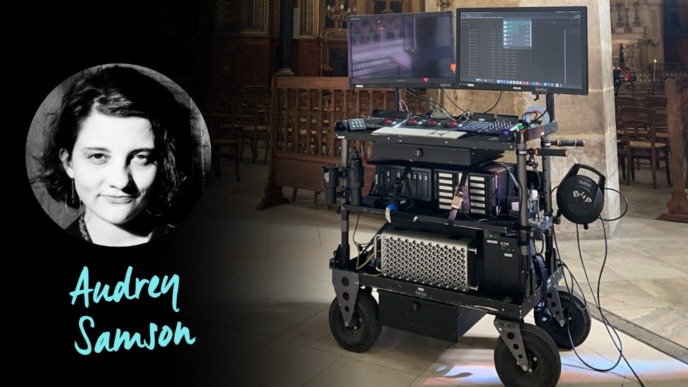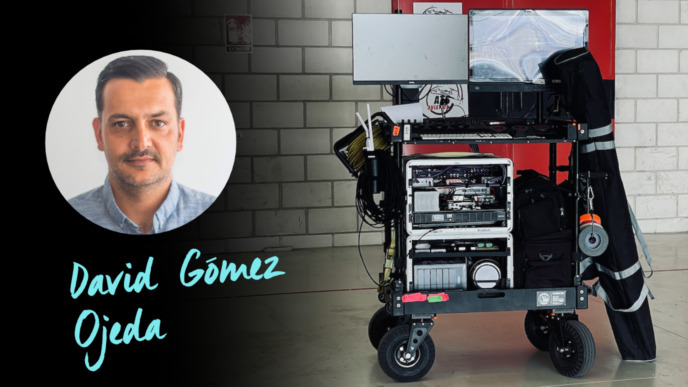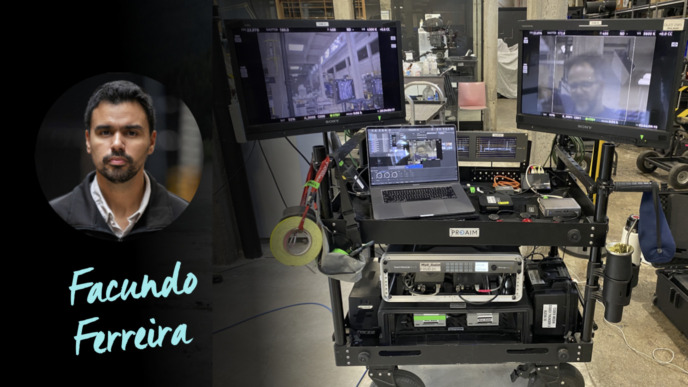
With his “ever-changing” DIT cart, Ben Whaley continuously adapts to all sorts of production needs and requirements. To accommodate such flexibility, he even developed his own piece of equipment, the WhaleyRail – a modular mounting frame for multiple production monitors and other accessories. In this interview, Ben shares detailed insights into his setup and an important piece of advice: Don’t let anyone with a bug zapper near your cart.
First of all, thank you very much for doing this interview with us! To start, could you please tell us a bit about yourself?
It’s my pleasure; thanks for having me. My name is Ben Whaley; I’m a DIT based out of Toronto, Canada. Out of school, I worked odd jobs in post-production, but I wasn’t getting much traction. Then the big move from film to digital cameras happened, and I was fortunate enough to have friends that clued me in to the commercials scene just as the Red One was gaining popularity. After a few years, I made the move to the union and have been working on features and TV series nearly exclusively since.

What does your work look like these days?
I’ve done a lot of TV, but more recently, features have been trending up. Streaming has been a boon for Toronto; it’s blurred the line between the quality of features and TV, and as a result, we’re seeing a greater need for DITs that come with all the toys. I involve myself as early as possible in the project to help the DP translate the visual narrative concept into a shootable grading plan. Then I collaborate with the lab, VFX, and finishing to make sure the metadata can track through post so that their versions exactly match what the DP sees on set. Once we get to set, my job is to support the DP and key technicals as they light and shoot, maintain our visual continuity with live grading and optical filters, manage exposures, and catch optical issues that might otherwise be overlooked. Footage will be ingested and synced to the live grades by either myself or my loader, depending on the job, and a fine pass is done in Davinci Resolve before sending footage to the lab along with the Resolve project. I’ll make still references available to the DP and the keys, so everyone has fast access to what we’ve done without having to rely on next-day streaming dailies.

We’re aware that every DIT’s setup varies. How would you describe yours?
I put a lot of thought into each show’s build-in prep. The cart should support the DP’s shooting workflow but also be agile and efficient, lean and mean. In a single term, I’d describe my cart setup as “ever-changing”.
Could you walk us through your cart’s components and the bits and pieces of your overall setup?
I have an Inovativ Deploy and Echo 36 to choose from. The Deploy is better for stairs and cramming into small spaces like bathrooms. The Echo is easier to handle on uneven terrain and has more real estate for storage and mounting points. On jobs where I have a loader, I’ll build a separate offload/QC station out of the second cart. I also have an Axis stand if we need a roving lightweight DP station. I have two Flanders DM250s for my main monitors and a Sony X2400 for the offload/QC station. I hand footage off to labs for processing, so I don’t need to go heavy on computing power – I have an M1 Mini for the Livegrade station, and the offload station is an older gen Mac Pro. I use OWC Thunderblades and 24TB Areca SSD RAID – I really don’t like waiting on copies. My lut-up workflow involves COLR boxes on the cameras. All clients, including the cart, connect to an access point on a battery plate, so the DIT cart isn’t necessarily needed in the loop to switch grades or maintain remote camera control. This opens up some options to scale my equipment to the power restrictions of the location. We can be as small as a monitor, iris controls, and a block battery if that’s what’s needed. Communication between myself, the DP, and the keys to managing expectations and making game plans is very important.

Personally speaking, what’s your favorite component of your setup?
I’m a bit biased – my favorite piece of kit on my cart is my WhaleyRail mounting system. When I migrated to my first Inovativ cart, I couldn’t find a product that did what I needed, so I developed the WhaleyRail. It’s like lego for mounting anything above the deck. I can get hard mount points exactly where I need them, the whole rig is super light, and it breaks down quickly after a show or to climb a flight of stairs more easily. Upgrade Innovations in Vancouver makes and distributes them now.
What has been the latest addition to your setup?
The Sony X2400 is my newest piece of kit. There aren’t a lot of set-ready panels at a reasonable price point that display UHD/HDR. It’s been very helpful at times to have the option to check footage in the deliverable format on the offload/QC cart.


Has your setup been involved in any notable stories that you’re willing to share with us?
Well – I don’t trust locations tents; that’s a given! They’re always liable to leak, collapse, or even blow away covered in weights. On one job, we set a room on fire (intentionally), tripped the supposedly-disabled studio sprinkler system (unintentionally), and my equipment was very nearly flooded. I’ve had spinning drives seize in -40°C weather. I’ve had to write off a monitor after a DP hit it with a bug zapper. I’ve de-infested my kit of earwigs after a day in a South African sugarcane field. There have been so many more interesting days that I’ve chosen to forget.

__________________________
Thanks a lot for sharing all these insights with us!

Ben Whaley, DIT
Ben Whaley is a Toronto-based DIT, mainly working on feature films and TV series. His “ever-changing” DIT cart lets him facilitate agile and efficient workflows on set.



